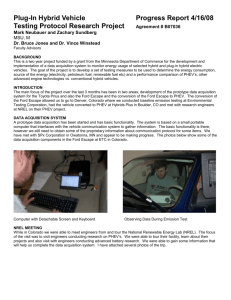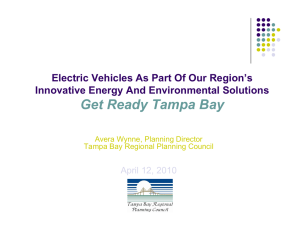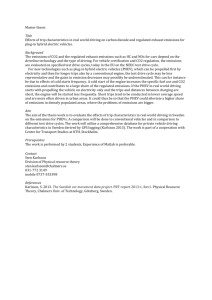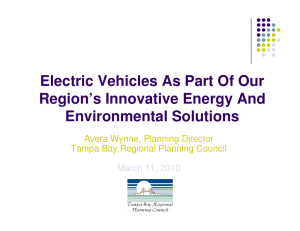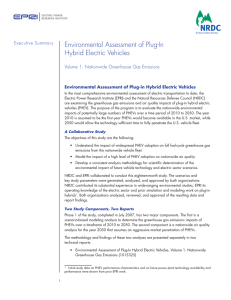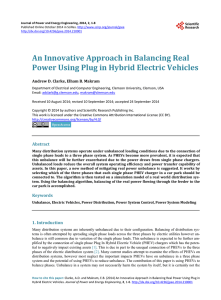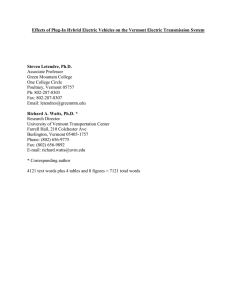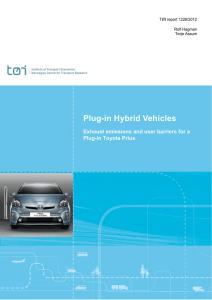Electric Transportation Mike Waters November 2009 1
advertisement
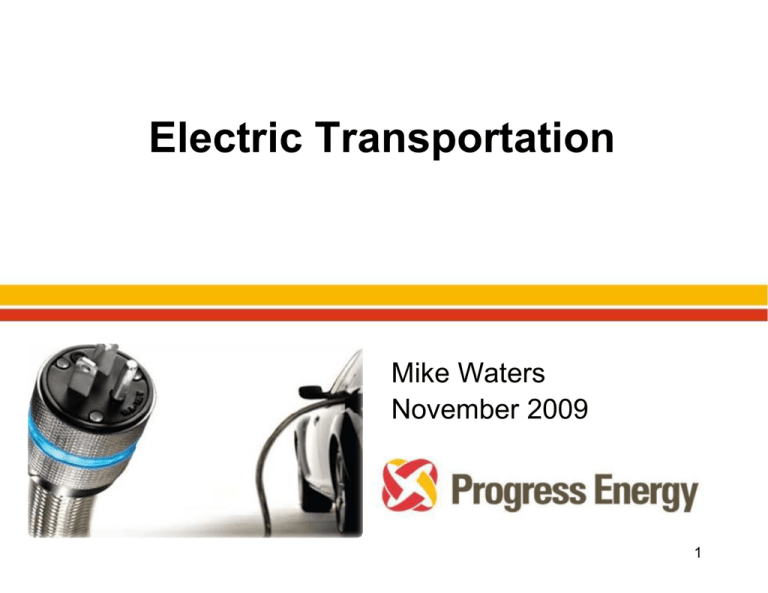
Electric Transportation Mike Waters November 2009 1 Situation today is very different than the 1990s Technology Plug-in hybrid electric technology eliminates range anxiety Improved batteries and longer range Marketplace Gas prices, energy security, GHG Not just driven by California Broad support and incentives 3 4 CLEANER • Fewer emissions and more easily mitigated CHEAPER DOMESTIC • Fuel costs much less than gas ¾ Electricity: ~$0.75/gale • Reduces dependence on foreign oil 5 Pacific NW National Lab Study CO2 emissions reduced by 27% NOx emissions reduced by 31% Urban air quality emissions greatly reduced: VOCs/NOx/CO reduced > 90% PM by 40% SO2 by 80% NRDC/EPRI Study CO2 reduced by 470 million tons annually by 2050 Total emissions of NOx, SO2, ozone, and VOC decrease 6 SAE J1772 standards under modification Level 1: 120 V 20 A breaker, separate cord Level 2: 240 V up to 100 A breaker, attached cord Level 3: Direct DC, high voltage (~50-200 kW) Charging at home will be the default, but opportunity charging will also be in demand Public access stations at key locations leading the market will be important to enable PEV adoption Access and payment models still in flux Important to have open and fair access early on “Smart Charging” will help avoid peak load 7 Projected 2010 U.S. Electrical Consumption plus 10 million Plug-in Hybrids (~ 8 kWh charge/day) Source: EPRI 8 PHEV or EREV Saturn VUE Chevrolet Volt ALL ELECTRIC Volvo PHEV Nissan Leaf Smart Mitsubishi iMIEV ? Chrysler: Jeep or Minivan BYD 3DFM Ford Escape PHEV Ford/Eaton Trouble Truck Toyota Prius PHEV Chrysler 200C Fisker Karma Ford Focus Ford Van VW Golf TwinDrive Dodge Circuit Mini-E Cadillac Converj Mercedes BlueCell Chrysler Minivan Tesla Subaru R1e The challenge is significant It will take a collaborative approach Automakers, utilities, government, academia, NGOs, equipments providers, builders, consumers, etc. Everybody has a role to play “Project Get Ready” is one model of cooperation 10 11 Slide courtesy of GM Plug-in vehicle are the hot topic in the past year Obama has set a target of 1 million by 2015 Significant tax credits exist today Up to $7,500 for light duty vehicle 10% credits for conversions, NEVs, 2/3 wheeled vehicles Up to 50% for infrastructure Stimulus grant money is potentially available Clean Cities, FOA28 State and local block grants 12 Plug-in Vehicle demonstrations 7 converted Prius, 2 Ford Escape, Bucket Truck UF Prius conversion City of St. Pete Ford Escape conversion Significant public outreach and education Technical consultant Research and development Evaluating business models for charging solutions and relationship to renewable energy Partnering with OEMs, cities, and non-profits 13 Plug-in vehicles are coming (again) Improved technologies reduce the barriers Electric transportation can improve air quality while reducing GHG and petroleum use Load is manageable Must be a collaborative effort Regions that are proactive will have vehicles earlier than others and realize the benefits Focus on process now, consider infrastructure later in 2010 Resource: www.ProjectGetReady.com 14 l February 5th, 2009 15

